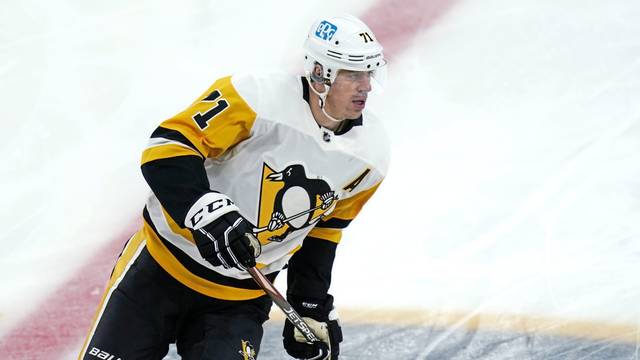Mark Madden: Evgeni Malkin's shot can fix Penguins' struggling power play
The Pittsburgh Penguins’ power play stinks and is unlikely to be fixed.
It ranks 22nd in the NHL with a conversion rate of 13.9%. It won’t always rank that low. It will generate hot streaks based solely on the unit’s talent, which is plentiful.
But right now is not one of those hot streaks.
The power play is 0 for 19 over its last four games. In 34-plus minutes, the unit mustered 20 shots while conceding 14. That’s while having one more man.
The Penguins’ power play ranks last in the NHL in shots per minute. They average 37.9 shots per 60 minutes. The league average is about 50. Toronto leads with 88.
It’s not possible to be worse than those numbers, but the Penguins try. Their entries, possession, pressure, puck retrieval and scoring chances all came up lame.
Those working the power play are too stubborn to change their method, which emphasizes lots of bad passing, little structure and even less shooting. Those coaching the power play are too impotent to implement what they want or make personnel changes as needed.
Sidney Crosby and Evgeni Malkin are solid on the PP, but rarely great. They don’t have that power-play knack like Mario Lemieux, Sergei Gonchar or Phil Kessel, though Kessel didn’t shoot nearly enough. (Lemieux did. It didn’t take much prodding, either.)
This is how I’d fix the power play. (Full disclosure: My theories are born of conversations on my radio show with ex-Penguin Mike Rupp and Jonathan Bombulie of this parish.)
Good power plays have something on which to hang their hats. For example, Washington has Alexander Ovechkin constantly blasting away from the left half-wall.
Malkin doing the same from the right half-wall should be Option A for the Penguins. Malkin can do it. He has done it. He just doesn’t do it enough.
Ovechkin’s cannons from his preferred spot are effective, regular and must be respected. Once teams lean in that direction, more space opens up for everybody else. On the occasions Ovechkin moves, it makes the foe’s penalty-kill scramble.
The opposing PK doesn’t know what the Penguins’ power-play is going to do. Neither does the Penguins’ power play. There’s no rhythm or pattern. It’s haphazard.
To facilitate Malkin becoming the target man, P.O Joseph should play up top. He’s got the skill, and he’s left-handed. Only a lefty can seamlessly feed Malkin in his wheelhouse. (Like Gonchar did.)
Kris Letang still can be involved. Play him on the left half-wall.
But the Penguins power play needs to be more about what works and less about being a reward for being one of the team’s best players. Nobody should be guaranteed a spot. (Or guaranteed anything else. The Penguins haven’t won a playoff series since 2018.)
Once you’ve identified the power play’s priority and facilitated its execution, Malkin starts dropping bombs. The occasional backdoor tap-in will follow. So will deflections and rebounds. So will momentum swings. The power play will be cumulative, which it never is now. You can’t always score, but you should usually put the opposition on its heels.
Ex-Penguin Patric Hornqvist has three power-play goals for Florida. The citizens here are wetting their pants by way of citing Hornqvist’s net-front presence as the PP’s missing link.
That could be true. It’s hard to tell, because the Penguins’ power play rarely gets the puck to the front of the net.
With Hornqvist gone, maybe the Penguins lack confidence in Guentzel as his net-front replacement and don’t whack random pucks at the net hoping they get turned into a chance. Guentzel has good touch near the crease, but Hornqvist’s size and strength extends plays, occupies defenders and makes him more difficult to play against.
The Penguins did plenty of work on their power play at practice Thursday. But the personnel were the same as usual.
The Penguins have one of hockey’s best power-play minds ever at their disposal. It’s shocking his input isn’t sought.
When Eddie Johnston coached the Penguins from 1980-83, his power play was like a Swiss watch. In those three seasons, the Penguins were second, first and sixth in power-play goals despite having a fraction of the current unit’s talent. Paul Gardner led the NHL in power-play goals in ’81-82 and ’82-83, netting 21 and 20, respectively.
Johnston’s power play used a pick-and-roll style he adapted from basketball after talking with Boston Celtics legend Tommy Heinsohn. Johnston did more with Pat Boutette and Mario Faubert than the current Penguins’ PP accomplishes with Crosby and Malkin.
Would Johnston’s tactics work now?
It doesn’t matter. If Johnston talked, these Penguins wouldn’t listen. It’s difficult to fix something that won’t admit it’s broke.
Remove the ads from your TribLIVE reading experience but still support the journalists who create the content with TribLIVE Ad-Free.

